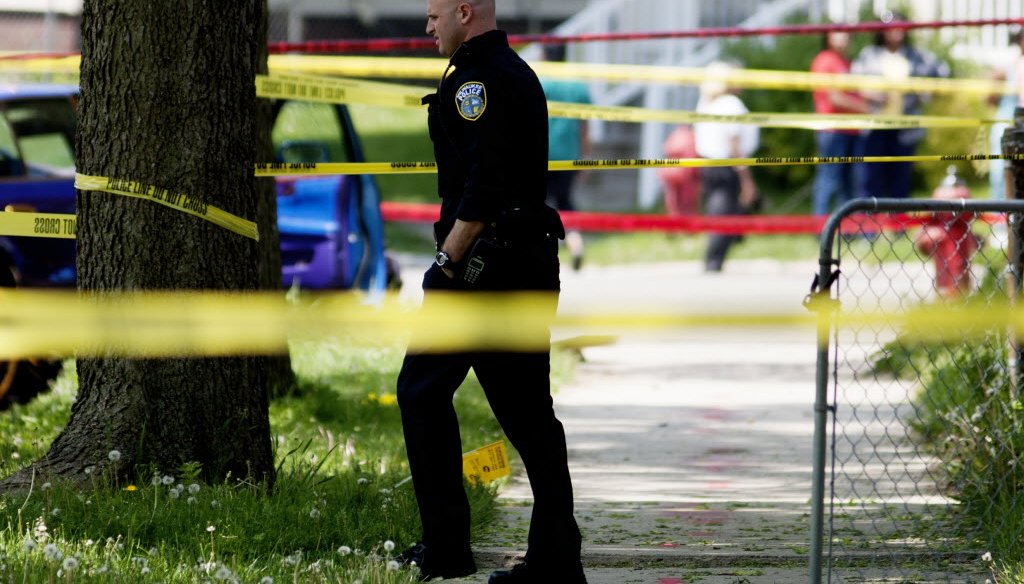



Police investigate the scene of a triple-shooting in Milwaukee on May 23, 2016. (Calvin Mattheis photo)
Resentment and recrimination often characterize political relations between Milwaukee and the rest of Wisconsin.
In the latest clash, the Milwaukee Public Schools board thwarted an effort by Republican state lawmakers to reform the low-performing district. That led the GOP leader of the Senate to say the Legislature might respond by cutting the district’s funding.
About two weeks later, on July 10, 2016, another GOP lawmaker issued a broadside against largely Democratic Milwaukee. State Sen. Van Wanggaard of Racine wrote an opinion piece in the Milwaukee Journal Sentinel that was laden with statistical claims unfavorable to the city -- including one making a national comparison about crime that we want to check.
"Recent complaints from Milwaukee leaders about their lack of state funding are misguided and lack perspective," the column began.
"Unfortunately," Wanggaard later wrote, "the only way to cut this expenditure is to reduce the number of people needing assistance — reducing poverty. But the failing school system and Milwaukee's crime problem prevent that."
Then came the claim we’re interested in, with Wanggaard saying "you're more likely to be the victim of a violent crime in Milwaukee than in 96 percent of the country."
Milwaukee is known for a relatively high violent crime rate. But this way of expressing that has some problems.
Trends in violent crime
Across the country, crime has been on a downward trend.
That’s what PolitiFact National reported in June 2016 in rating as Pants on Fire Donald Trump’s claim that "crime is rising." With regard to violent crime, our colleagues checked FBI figures through 2014, the latest year for which complete figures are available. They found that nationally, the rates of violent crime per 100,000 people have been falling on an almost uninterrupted basis since the early 1990s.
As counted by the FBI’s Uniform Crime Reporting (UCR), violent crime includes murder, rape, robbery and aggravated assault.
Milwaukee’s violent crime rate has been among the highest among large cities. In 2014, there were 8,864 violent crimes reported in the city, according to the FBI figures. That was up 8 percent from 8,194 in 2013.
Now, to Wanggaard’s claim.
Wanggaard’s evidence
To back the statement, Wanggaard’s staff cited rankings from two websites that rank places to live. Each used the FBI’s UCR violent crime figures for 2014.
AreaVibes.com says Milwaukee is safer than 4 percent of the cities in the United States. Another way to say that would be that Milwaukee’s violent crime rate is higher than 96 percent of the country.
NeighborhoodScout.com says the figure is 3 percent.
Michael O’Hear, a law professor at Marquette University in Milwaukee, told us the rankings give some basis for Wanggaard’s 96 percent claim.
But O’Hear and other criminal justice experts told us there are problems with the claim.
"It’s sort of a dubious measure on so many grounds," said Alfred Blumstein, an emeritus professor of urban systems and operations research Carnegie Mellon University in Pittsburgh.
Comparison problems
1. UCR figures are solid. But the FBI "strongly discourages" using them to make rankings to evaluate different communities, saying:
"These incomplete analyses have often created misleading perceptions which adversely affect geographic entities and their residents. For this reason, the FBI has a long-standing policy against ranking participating law enforcement agencies on the basis of crime data alone … many factors cause the nature and type of crime to vary from place to place."
2. Across the country, violent crime generally is concentrated in larger cities, so it stands to reason there is less violent crime in most parts of the country. But the figures used in the website rankings compare Milwaukee with cities such as Mount Pleasant near Racine (15 violent crimes in 2014) and Sun Prairie (32) near Madison that have a population as low as 25,000.
"There’s a world of difference between a city of 25,000 and a city the size of Milwaukee (population 600,000)," O’Hear said.
3. Violent crime in Milwaukee is concentrated in certain neighborhoods, while other neighborhoods carry no more risk of violent crime than many suburban neighborhoods. In other words, you’re not suddenly at great risk of being a violent crime victim simply by crossing the city limits.
"Usually if you’re not hanging out" in high-crime neighborhoods, "your chances of being a victim of crime are pretty low," said Michael Jacobson, executive director of the City University of New York Institute for State & Local Governance.
Our rating
Wanggaard said: "You're more likely to be the victim of a violent crime in Milwaukee than in 96 percent of the country."
Three rankings using violent crime rates from the FBI give Milwaukee such a ranking.
But the FBI warns against using its figures to do rankings; the rankings compare Milwaukee to relatively tiny cities; and the claim makes a broad claim about Milwaukee but ignores the fact that most violent crime in the city is limited to certain neighborhoods.
For a statement that is partially accurate but takes things out of context, our rating is Half True.
Milwaukee Journal Sentinel, "Current state spending for Milwaukee is unsustainable without changes," July 10, 2016
Email, state Sen. Van Wanggaard staff member Scott Kelly, July 11, 2016
AreaVibes.com, "Milwaukee, WI crime," accessed July 12, 2016
NeighborhoodScout.com, "Crime rates for Milwaukee, WI," accessed July 11, 2016
Email, University of Maryland criminology and criminal justice professor Ray Paternoster, July 12, 2016
Interview, Marquette University law professor Michael O’Hear, July 12, 2016
Interview, City University of New York Institute for State & Local Governance executive director Michael Jacobson, July 12, 2016
FBI, "Uniform Crime Reporting statistics: Their proper use," January 2011
FBI, Uniform Crime Reports for Wisconsin cities, 2014
Interview, Carnegie Mellon University emeritus professor of urban systems and operations research Alfred Blumstein, July 14, 2016
In a world of wild talk and fake news, help us stand up for the facts.
